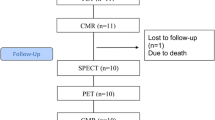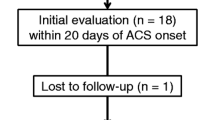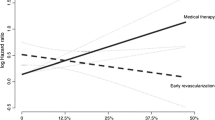Abstract
Purpose
Microcirculatory failure after reperfusion is clinically indicated to cause reperfusion injury whereas excessive intracellular calcium ion overload is experimentally proved as a key mechanism of reperfusion injury. We hypothesized that technetium-99m (99mTc) pyrophosphate (Tc-PYP) uptake in injured but viable infarct-related myocardium with preserved myocardial perfusion after reperfusion estimated by thallium-201 (201Tl) uptake would be associated with final functional recovery.
Methods
Dual-isotope Tc-PYP/201Tl single-photon emission computed tomography (SPECT) was performed 2 days after successful reperfusion therapy in patients with first acute myocardial infarction, and 50 patients (63 ± 13 years old, female 22%) with preserved 201Tl uptakes of ≥50% in reperfused myocardium was followed for 1 month. Tc-PYP uptake was assessed as the heart-to-sternum (H/S) ratio. Two-dimensional echocardiography was also performed 2 days and 1 month after reperfusion to evaluate functional recovery.
Results
High Tc-PYP uptake, defined as the H/S ratio ≥0.81, was predictive of chronic phase no functional recovery (73.7% in 14 of 19 patients with high uptake vs 16.1% in five of 31 patients without those, p < 0.0001). After adjustment for potential confounding variables, including electrocardiographic persistent ST segment elevation at 1 h after reperfusion, high Tc-PYP uptake remained independently predictive of no functional recovery with odds ratio of 8.7 (95% confidential interval = 2 to 38.7; p = 0.005).
Conclusion
High Tc-PYP uptake in reperfused but viable infarct-related myocardium was a powerful predictor of no functional recovery, which may reflect excessive intracellular calcium ion overload caused by reperfusion injury. Tc-PYP/201Tl dual-isotope SPECT imaging can provide prognostic information after reperfusion.



Similar content being viewed by others
References
Yellon DM, Baxter GF. Protecting the ischemic and reperfused myocardium in acute myocardial infarction: distant dream or near reality? Heart 2000;83:381–7.
Brosh D, Assali AR, Mager A, Porter A, Hasdai D, Teplitsky I, et al. Effect of no-reflow during primary percutaneous coronary intervention for acute myocardial infarction on six-month mortality. Am J Cardiol 2007;99:442–5.
Kamp O, Lepper W, Vanoverschelde JL, Aeschbacher BC, Rovai D, Assayag P, et al. Serial evaluation of perfusion defects in patients with a first acute myocardial infarction referred for primary PTCA using intravenous myocardial contrast echocardiography. Eur Heart J 2001;22:1485–95.
Wu KC, Zerhouni EA, Judd RM, Lugo-Olivieri CH, Barouch LA, Schulman SP, et al. Prognostic significance of microvascular obstruction by magnetic resonance imaging in patients with acute myocardial infarction. Circulation 1998;97:765–72.
Claeys MJ, Bosmans J, Veenstra L, Jorens P, De Raedt H, Vrints CJ. Determinants and prognostic implications of persistent ST-segment elevation after primary angioplasty for acute myocardial infarction: importance of microvascular reperfusion injury on clinical outcome. Circulation 1999;99:1972–7.
Ndrepepa G, Mehilli J, Martinoff S, Schwaiger M, Schomig A, Kastrati A. Evolution of left ventricular ejection fraction and its relationship to infarct size after acute myocardial infarction. J Am Coll Cardiol 2007;50:149–56.
Yellon DM, Hausenloy DJ. Myocardial reperfusion injury. N Engl J Med 2007;357:1121–35.
Takayama E, Guo LL, Digerness SB, Pike MM. Early reperfusion levels of Na(+) and Ca(2+) are strongly associated with postischemic functional recovery but are disassociated from K (ATP) channel-induced cardioprotection. J Mol Cell Cardiol 2004;37:483–96.
Levitsky S. Protecting the myocardial cell during coronary revascularization, The William W. L. Glenn Lecture. Circulation 2006;114:I339–43.
Beller GA. Myocardial imaging for the assessment of myocardial viability. In: Skorton DJ, editor. Cardiac imaging, a companion to Braunwald’s heart disease. 2nd ed. Philadelphia: Saunders; 1996. p. 996–1011.
Dilsizian V. Thallium-201 scintigraphy: experience of two decades. In: Dilsizian V, editor. Myocardial viability: a clinical and scientific treatise. Armonk, NY: Futura; 2000. p. 265–313.
Okuda K, Nohara R, Fujita M, Tamaki N, Konishi J, Sasayama S. Technetium-99m pyrophosphate uptake as an indicator of myocardial injury without infarct. J Nucl Med 1994;35:1366–70.
Jansen DE, Corbett JR, Buja LM, Hansen C, Ugolini V, Parkey RW, et al. Quantification of myocardial injury produced by temporary coronary artery occlusion and reflow with technetium-99m-pyrophosphate. Circulation 1987;75:611–7.
Chien KR, Reeves JP, Buja LM, Bonte F, Parkey RW, Willerson JT. Phospholipid alterations in canine ischemic myocardium. Temporal and topographical correlations with Tc-99m-PPi accumulation and an in vitro sarcolemmal Ca2+ permeability defect. Circ Res 1981;48:711–9.
Olson HG, Lyons KP, Aronow WS, Stinson P, Kuperus J, Waters HJ. The high-risk angina patient. Identification by clinical features, hospital course, electrocardiography and technetium-99m stannous pyrophosphate scintigraphy. Circulation 1981;64:674–84.
Isoda H, Itagaki Y, Nomura N, Urushida T, Naitou A, Watanabe A, et al. Dual radionuclide single-photon emission computed tomography in the prediction of further ischemic risk after acute myocardial infarction. Ann Nucl Med 1998;12:179–83.
Ichihara T, Ogawa K, Motomura N, Kubo A, Hashimoto S. Compton scatter compensation using the triple-energy window method for single- and dual-isotope SPECT. J Nucl Med 1993;34:2216–21.
Akutsu Y, Shinozuka A, Nishimura H, Li H, Huang TY, Yamanaka H, et al. Significance of ST-segment morphology noted on electrocardiography during the recovery phase after exercise in patients with ischemic heart disease as analyzed with simultaneous dual-isotope single photon emission tomography. Am Heart J 2002;144:335–42.
Akutsu Y, Shinozuka A, Kodama Y, Li H, Yamanaka H, Katagiri T. Significance of extension of exercise-induced ischemia toward apex of left ventricle. Int J Cardiol 2004;93:269–79.
Ito Y, Uehara T, Fukuchi K, Tsujimura E, Hasegawa S, Nishimura T. Comparison of dual-isotope acquisition of Tl-201 and Tc-99m tetrofosmin for the detection of ischemic heart disease and determination of the optimal imaging time of Tc-99m tetrofosmin. Nucl Med Commun 1998;19:119–26.
Johnson LL. Imaging acute myocardial necrosis (monoclonal antibodies and technetium-99m pyrophosphate). In: Skorton DJ, editor. Cardiac imaging, a companion to Braunwald’s heart disease. 2nd ed. Philadelphia: Saunders; 1996. p. 1012–20.
Takahashi T, Hiasa Y, Ohara Y, Miyazaki S, Ogura R, Miyajima H, et al. Relation between neutrophil counts on admission, microvascular injury, and left ventricular functional recovery in patients with an anterior wall first acute myocardial infarction treated with primary coronary angioplasty. Am J Cardiol 2007;100:35–40.
Sharir T, Germano G, Kavanagh PB, Lai S, Cohen I, Lewin HC, et al. Incremental prognostic value of post-stress left ventricular ejection fraction and volume by gated myocardial perfusion single photon emission tomography. Circulation 1999;100:1035–42.
Lepper W, Sieswerda GT, Vanoverschelde JL, Franke A, de Cock CC, Kamp O, et al. Predictive value of markers of myocardial reperfusion in acute myocardial infarction for follow-up left ventricular function. Am J Cardiol 2001;88:1358–63.
Neumann F, Kosa I, Dickfeld T, Blasini R, Gawaz M, Hausleiter J, et al. Recovery of myocardial perfusion in acute myocardial infarction after successful balloon angioplasty and stent placement in the infarct-related coronary artery. J Am Coll Cardiol 1997;30:1270–6.
Feldman LJ, Himbert D, Juliard JM, Karrillon GJ, Benamer H, Aubry P, et al. Reperfusion syndrome: relationship of coronary blood flow reserve to left ventricular function and infarct size. J Am Coll Cardiol 2000;35:1162–9.
Mizote I, Ueda Y, Ohtani T, Shimizu M, Takeda Y, Oka T, et al. Distal protection improved reperfusion and reduced left ventricular dysfunction in patients with acute myocardial infarction who had angioscopically defined ruptured plaque. Circulation 2005;112:1001–7.
Popma JJ, Cox N, Hauptmann KE, Reifart N, Virmani R, Emira K, et al. Initial clinical experience with distal protection using the Filter Wire in patients undergoing coronary artery and saphenous vein graft percutaneous intervention. Catheter Cardiovasc Interv 2002;57:125–34.
Tani M, Neely JR. Role of intracellular Na+ in Ca2+ overload and depressed recovery of ventricular function of reperfused ischemic rat hearts. Possible involvement of H+–Na+ and Na+–Ca2+ exchange. Circ Res 1989;65:1045–56.
Tani M, Neely JR. Na+ accumulation increases Ca2+ overload and impairs function in anoxic rat heart. J Mol Cell Cardiol 1990;22:57–72.
Fukuda H, Luo CS, Gu X, Guo L, Digerness SB, Li J, et al. The effect of K (ATP) channel activation on myocardial cationic and energetic status during ischemia and reperfusion: role in cardioprotection. J Mol Cell Cardiol 2001;33:545–60.
Ambrosio G, Weisman HF, Mannisi JA, Becker LC. Progressive impairment of regional myocardial perfusion after initial restoration of postischemic blood flow. Circulation 1989;80:1846–61.
Uren NG, Crake T, Lefroy DC, De Silva R, Davies GJ, Maseri A. Reduced coronary vasodilator function in infarcted and normal myocardium after myocardial infarction. N Engl J Med 1994;331:222–7.
Ito H, Iwakura K, Oh H, Masuyama T, Hori M, Higashino Y, et al. Temporal changes in myocardial perfusion patterns in patients with reperfused anterior wall myocardial infarction. Circulation 1995;91:656–62.
Krause T, Kasper W, Zeiher A, Schuemichen C, Moser E. Relation of technetium-99m pyrophosphate accumulation to time interval after onset of acute myocardial infarction as assessed by a tomographic acquisition technique. Am J Cardiol 1991;68:1575–9.
Kawaguchi K, Sone T, Tsuboi H, Sassa H, Okumura K, Hashimoto H, et al. Quantitative estimation of infarct size by simultaneous dual radionuclide single photon emission computed tomography: comparison with peak serum creatine kinase activity. Am Heart J 1991;121:1353–60.
Acknowledgement
The authors wish to thank the medical, technical, and laboratory staff, Dr. Noritaka Seino, of the Service of Nuclear Medicine, and Drs. Takeshi Kondou, Mitsuharu Muto, and Shigeto Tsukamoto, of the Catheterization Laboratory of Showa University Hospitals who actively participated in the data collection.
Author information
Authors and Affiliations
Corresponding author
Rights and permissions
About this article
Cite this article
Akutsu, Y., Kaneko, K., Kodama, Y. et al. Technetium-99m pyrophosphate/thallium-201 dual-isotope SPECT imaging predicts reperfusion injury in patients with acute myocardial infarction after reperfusion. Eur J Nucl Med Mol Imaging 36, 230–236 (2009). https://doi.org/10.1007/s00259-008-0922-y
Received:
Accepted:
Published:
Issue Date:
DOI: https://doi.org/10.1007/s00259-008-0922-y




